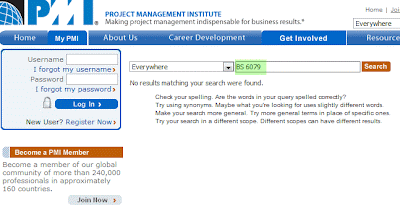The latest news in PM circle (Especially those who aim at PMP certification) is about the new Body of Knowledge (BOK) from Project Management Institute (PMI) scheduled to release in December 2008. PMI has already published the key changes in the new standard – PMBOK® Guide 4th Edition. You may find the link here . (Thank you Rich for the link!). One of the major changes which I have noticed is the change in the process nomenclature to ‘Verb-Noun’ format. Even though there won’t be drastic changes in the PMP exam pattern, I expect many people to stay away from applying for certification during the transition period. People may consider preparing for the PMP based on latest standard (4th edition) , so that it will help in re-examinations if any one fail to make it in the first attempt.
More over, PMP exam goes wery much with terminologies and hence candidates may have a fear of getting confused with outdated terminology (if any) in case if they need to study the new standard while re-appearing.
Standards are to be revised to keep them aligned with the technological and conceptual changes happening in the industry from time to time. How ever, existence of many standards for the same purpose sometimes makes practitioners life difficult. (Especially who are working with international projects). For mechanical items we have already British, American and Dutch standards(BS-IS, DN, API, ANSI..etc) . I think ISO has succeeded to great extent in uniting various standards and arriving with widely accepted standards. The best examples are ISO 9001, ISO 14001 and OHSAS 18001. I have involved in Quality certifications in present and previous employments and recently got certified from Bureau Veritas (Certified Internal Auditor for Integrated Management System). All these standards and the audits associated with them go behind the ‘Standard Terminologies’ and ‘Methods’ to great extent.
Back to Project Management standards. BSI has got BS-6079-1-2002 , as the standard for Project Management. I have read it a couple of times and found it as very much lighter than PMI’s PMBOK® 3rd Edition(PMBOK is ANSI/PMI 99-001-2004). PMI has taken very extensive approach (may be because they are focused on PM only) than BSI in the development of the standards. There were no revisions to BS 6079 after 2002 , how ever PMI has released 3rd edition to PMBOK in 2004 and kept the pace of up gradation steady by conducting several studies, research work and discussions. They have now come up with PMBOK® 4th Edition, which they claim to “ reflect the evolving knowledge within the profession of project management”.
It was a year back; ISO has announced commencement of the work on a new international standard for Project Management (ISO 21500). BSI released a new letter in this regard (read it here), which claim ISO 21500 as an extension of BS-6079-1-2002. How ever in the ISO news letter regarding the same subject (read it here) there is no mention about BS-6079, other than a mention of BSI, who was the host to the kick off ceremony (held in London
I am not aware about the involvement/contribution of PMI in the development of ISO 21500 (My search for ISO 21500 in the PMI website returned no results! ) I would like to hear from anyone who knows about this.
I have checked for the cross reference of the BS, PMI & ISO standards in their respective websites and the following are the results:
I hope ISO 21500 is expected to release some where in 2010.
Take a look at the possible structure of ISO 21500, as per the above mentioned presentation:
PMBOK® 3rd Edition, focus on 5 key processes in 9 Knowledge areas.
- 5 Project Management Process Groups
- 9 Knowledge Areas
- 44 project management processes
Check out this link: http://www.viva-it.com/ipm/pmbok.htm
How many standards do we need?
Well my answer is ‘One’. Standard stands for ‘standardisation’ or ‘uniformity’. Now world is like a global village. People are working in multi ethnic – multi national teams. A project happening some where in middle east can have a German consultant working for a British client employing an American contractor. Project Management itself is an evolving profession and any one can say undoubtedly that PMI has played the main role in bringing up identity for that. The certifications, standards and marketing initiatives by PMI have made project management, a widely discussed and distinguished topic.
A new ISO standard for Project Management is always welcome, but it shall absorb all the good features of PMI & BS standards. I hope the standard committees are working in a collaborative way and we can expect release of ‘ONE’ standard, which is accepted by all PM organisations and PM practitioners across the world by the end of first decade of this millennium.
By the way, I am already sitting cross legged to watch the new PMBOK 4th edition and kept my desk ready to keep a copy of ISO 21500!!



















































